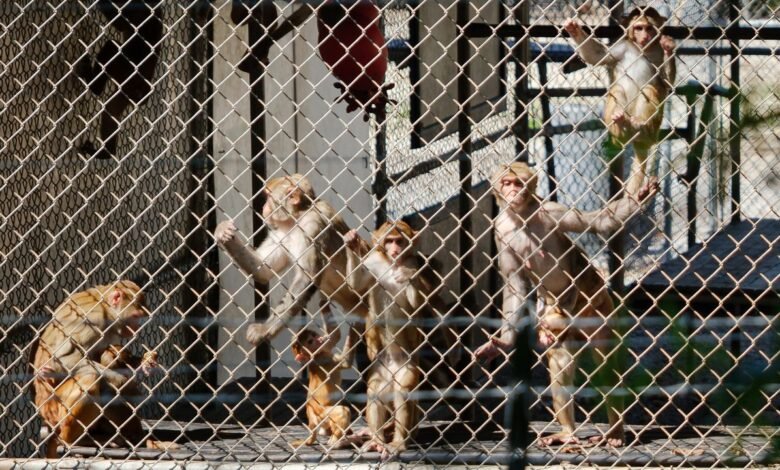The Runaway Monkeys Upending the Animal-Rights Movement

The collaboration between certain MAGA influencers and animal-rights activists has drawn out the most confrontational tendencies within each camp. This summer, Loomer and White Coat Waste took aim at an unusual target: Nicole Kleinstreuer, a toxicologist who is spearheading the N.I.H.’s effort to expedite, of all things, the replacement of animals in regulatory testing and research. Under Kleinstreuer’s leadership, the agency has launched a new office to develop and validate alternatives to animal studies, such as computer simulations and “organ on a chip” technologies. Kleinstreuer has said that she wants to “create lasting change for animal-free science.” But because she has echoed the scientific consensus—namely that, in the meantime, some animals remain necessary—White Coat Waste has branded her an enemy of progress and a “Fauci-loving ‘animal testing czar.’ ” Kleinstreuer, who subsequently received harassing messages and death threats online, has required security protection.
White Coat Waste’s criticism of Kleinstreuer has set it apart from the broader animal-rights movement. (“Have they lost their fucking minds?” Lisa Jones-Engel, the PETA scientist, said.) It is far from the only group, however, peddling the claim that an immediate end to animal research would be not only ethically justified but scientifically sound. This absolutist framing elides the fact that, though non-animal methods are highly effective in certain areas—such as skin sensitivity and eye irritation—they cannot replicate the complexity of living, functioning organisms, especially in efforts to understand whole-body reactions, neurochemistry, and progressive disease. Monkeys remain critical, not least for vaccine development and studying reproductive health. As an N.I.H. official wrote in a letter to members of White Coat Waste’s board, “True progress in this area cannot occur overnight—it takes time, and pretending otherwise is misleading, counterproductive, and dangerous.”
Pretending otherwise, though, holds greater emotional appeal. “People want the idea that we don’t need animals anymore to be true because they love animals,” Heather Sidener, a former head of clinical medicine at the Oregon National Primate Research Center, said. “They haven’t really had the hard conversation with themselves about, What if it was my husband? What if it was my child? Would I really say to them, ‘I think you should die because I don’t think we should use animals to see if this new medicine is safe’?” Cindy Buckmaster, a scientist and a former chair of Americans for Medical Progress, an advocacy group for animal research, told me that when we no longer need lab animals it will be the “happiest day of my life”—but that, until then, researchers should insure that each animal they do use is made to count. “The way we view animals has changed a lot in the past twenty years,” she said, “and we need to own up to our shortcomings.”
After his disillusionment, Gluck, the primate researcher, retrained as an ethicist. In this role, he often finds himself giving lectures on the moral quandaries posed by his past career. Though his audience sometimes looks to him for prescriptions, he tends to avoid TED-talk bromides and ten-point plans, emphasizing, instead, his epistemic humility. There is still so much we don’t know about monkeys—but what we do know, he contends, should make scientists worry that the conditions of captivity are damaging their research. “The primary question we have to be concerned with is: how do we do this differently?” he told me recently. “Who are these animals? What is their life like? How can you create an environment that is least abusive?” Recognizing that animals are complex beings, with complex needs, may not only reduce their suffering but also yield better science.
A few weeks after my trip to Yemassee, the remaining macaques were apprehended after trappers noticed their footprints in some freshly fallen snow. Westergaard announced that the monkeys were healthy, safe, and celebrating their reunion. PETA had its doubts. Someone in town had told the activists that a monkey had been hit by a car, and the group was now demanding that Alpha Genesis provide “proof of life.” On Facebook, Westergaard thanked the people of Yemassee for their support during the recapture mission. “As for PETA,” he added, “they can go f*** themselves.”
Throughout the year, Westergaard did not respond to my texts, calls, voice mails, or e-mails; when I visited his office to request an interview, security escorted me off the premises. Neither he nor his company responded to questions about animal-welfare violations and allegations of negligence. Meanwhile, he continued to spar with PETA online. At one point, he denounced the documents that it had released from Strickland as part of a “misinformation campaign” that sought “to erode public trust in critical research institutions.” This seemed curious, since Westergaard had spent much of the spring and summer cozying up to an Administration that routinely attacked such institutions. In May, after Alpha Genesis passed its most recent U.S.D.A. inspections without any citations, Westergaard announced his company’s unwavering support for Trump’s Make America Healthy Again initiative. “We believe that cutting-edge science and compassionate care go hand-in-hand,” he said, adding that the recent inspection results reflected “the organization’s proactive, professional approach to research and animal husbandry.” One of his press releases featured an A.I.-generated illustration of three grinning macaques in MAHA baseball caps. Another euphemistically described the axe that the Administration has taken to the scientific enterprise as “programmatic changes in research priorities.” That these “programmatic changes” threaten to demolish not just animal research but one of its crowning achievements—the reduction of childhood illness and death through vaccination—went unmentioned.




